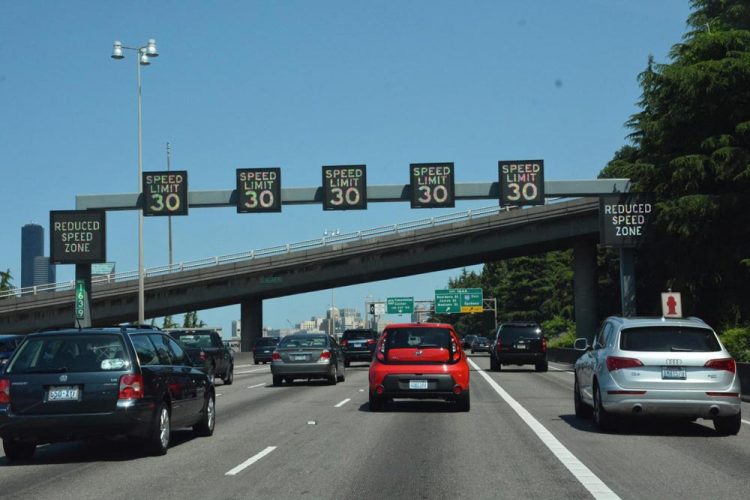Variable speed limits could reduce crashes, ease congestion in highway work zones

Praveen Edara found that using variable speed limits similar to this one in construction zones may ease congestion, reduce crashes and make work zones safer for both workers and travelers nationally. Credit: Steve Schar
Researchers at the University of Missouri have studied systems to alleviate inevitable backups and delays. Researchers found that using variable speed limits in construction zones may ease congestion, reduce crashes and make work zones safer for both workers and travelers nationally.
With assistance from the Missouri Department of Transportation, Praveen Edara, associate professor of civil and environmental engineering in the MU College of Engineering, tested the use of variable advisory speed limit (VASL) systems and the effect they may have on lessening congestion and reducing rear-end and lane-changing accidents on a fairly dangerous stretch of I-270, a major four-lane highway in St. Louis.
“The idea was to see if warning drivers of slower speeds ahead helped reduce crashes,” Edara said. “Where there is queueing, if drivers are not aware of the queue downstream, they don't have enough time to hit the brakes to slow down or stop, thus, increasing the likelihood of a crash. Instead of posting a message asking them to slow down, the VASL system posts an advisory speed limit based on the actual downstream traffic speed, so drivers would know that if they're driving 50 mph, they should slow to 30 mph downstream.”
Edara's data collection and simulation analysis uncovered a few key pieces of data. First, the use of VASL systems is effective in gradually slowing drivers as they enter work zones. VASL use resulted in a 39 to 53 percent decrease in average queue length, and just a 4 to 8 percent increase in travel time.
Additionally, using VASL meant that maximum speed differences also decreased by as much as 10 mph, and the chance of rear-end collisions dropped by 30 percent. Researchers also noted a 20 percent decrease in lane changing conflicts. Essentially, travel time was slightly longer, but lines were shorter and collisions were less frequent.
“You can get both safety benefits and mobility benefits by deploying variable advisory speed limit systems in work zones,” Edara said.
“Evaluation of variable advisory speed limits in congested work zones” recently was published in the Journal of Transportation Safety and Security. Carlos Sun, an MU professor of civil and environmental engineering, and Yi Hou a doctoral student at Mizzou, co-authored the study.
Media Contact
All latest news from the category: Transportation and Logistics
This field deals with all spatial and time-related activities involved in bridging the gap between goods and people, including their restructuring. This begins with the supplier and follows each stage of the operational value chain to product delivery and concludes with product disposal and recycling.
innovations-report provides informative reports and articles on such topics as traffic telematics, toll collection, traffic management systems, route planning, high-speed rail (Transrapid), traffic infrastructures, air safety, transport technologies, transport logistics, production logistics and mobility.
Newest articles

“Nanostitches” enable lighter and tougher composite materials
In research that may lead to next-generation airplanes and spacecraft, MIT engineers used carbon nanotubes to prevent cracking in multilayered composites. To save on fuel and reduce aircraft emissions, engineers…

Trash to treasure
Researchers turn metal waste into catalyst for hydrogen. Scientists have found a way to transform metal waste into a highly efficient catalyst to make hydrogen from water, a discovery that…

Real-time detection of infectious disease viruses
… by searching for molecular fingerprinting. A research team consisting of Professor Kyoung-Duck Park and Taeyoung Moon and Huitae Joo, PhD candidates, from the Department of Physics at Pohang University…





















